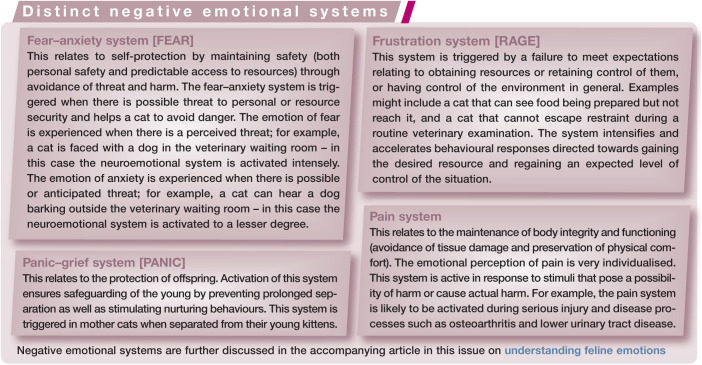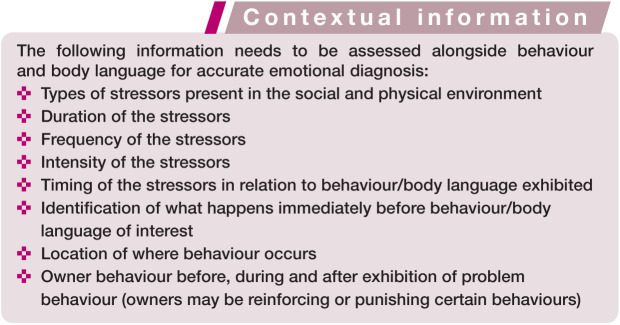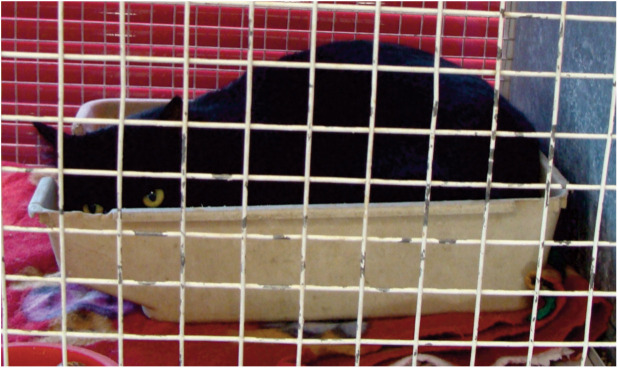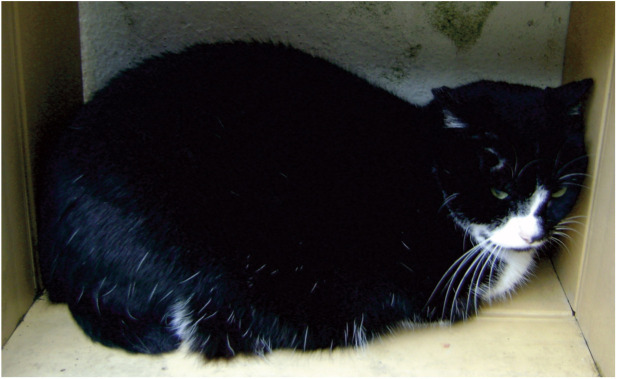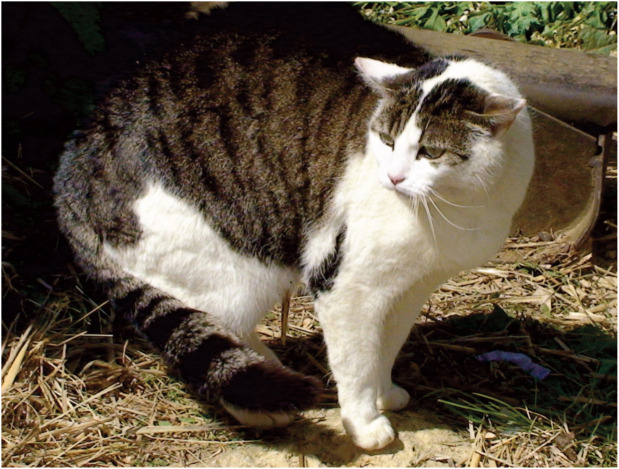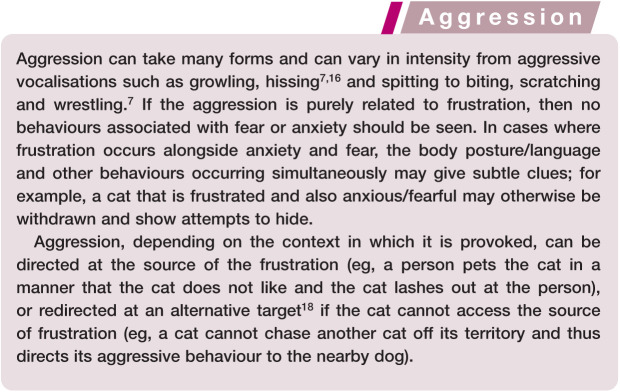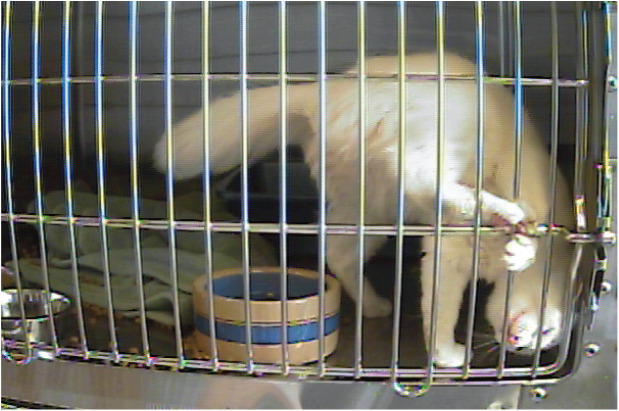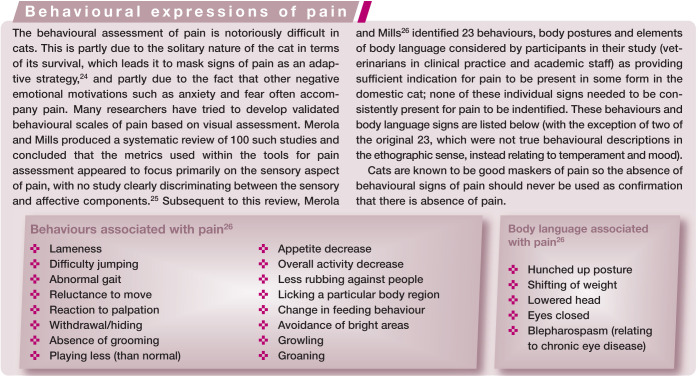Abstract
Practical relevance:
Crucial to successful treatment of problem behaviour and optimising the welfare of the individual cat is determining which underpinning emotion(s) are involved in the presentation of the behaviour. Feline emotions are not feelings per se, but motivational-emotional systems that are responsible for instinctual emotional arousal. Often different interventions are required to alleviate different negative emotional motivations.
Clinical challenges:
Identifying different emotional motivations and the arousal level associated with them solely from observations of behaviour and body language is a difficult task because, as with any species, the behavioural repertoire of the domestic cat is finite and the same behaviour may occur with the activation of different emotional systems. In addition, cats, like people, may experience more than one emotion at the same time or switch quickly between emotional motivations, and this further complicates identification. The behavioural assessment of pain is also notoriously difficult in cats.
Evidence base:
This review draws on the published literature where available and, where there is a paucity of research, on hypotheses derived from observations of professionals in the field.
Global importance:
Being able to recognise and assess feline emotional motivations in order to address problem behaviours and improve welfare is important for all veterinarians who see cats.
Introduction
Activation of various emotional systems with defined neuroanatomy underlies all feline behaviour – such systems have been well researched and described in the scientific literature. one widely used theoretical framework within which to view emotional motivation and interpret behaviour is that developed by the neuroscientist Panksepp (1998). 1 His approach categorises emotional motivations into positive emotional systems (the SEEKING system [reward expectancy], PLAY system [social play], LUST system [sexuality], CARE system [nurturance]) and negative emotional systems (the RAGE system [frustration], FEAR system [fear and anxiety] and PANiC system [separation distress]).
In addition, the emotional motivation of pain, although not considered by Panksepp as a distinct emotional system (but instead as part of the FEAR system), should not be underestimated when it comes to problem behaviour, both as a primary cause and as an additional factor that worsens problem behaviour. As well as being experienced at the sensorial level, pain also contains emotional motivation components related to the maintenance of body integrity and functioning (see later). 2 Thus, every cat exhibiting problem behaviour should be assessed for current signs of pain and the possibility of fearing anticipated pain. See the accompanying article on understanding feline emotions in this issue for a detailed review of these emotional systems and how they relate to problem behaviours in the domestic cat.
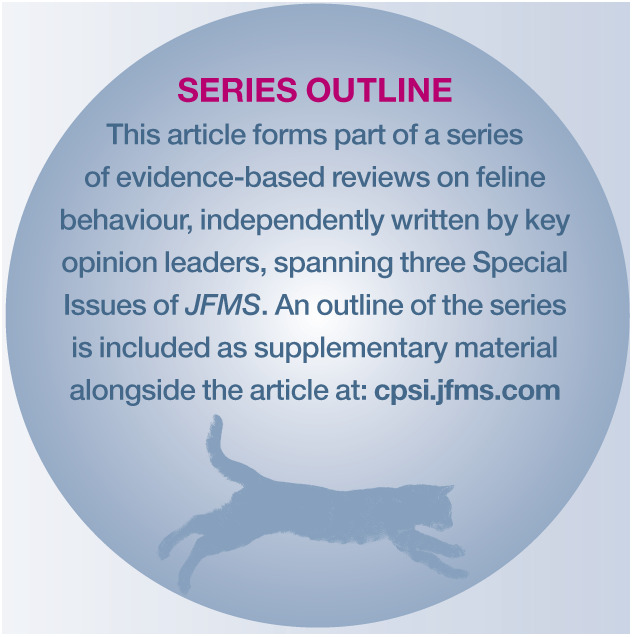
Identifying which underpinning emotions are involved in the presentation of problem behaviour is vital to successful treatment and optimising the welfare of the individual. For example, this allows the promotion of positive emotional motivations and the reduction or cessation of long-term negative emotional motivations, both of which can improve welfare. Treatment of problem behaviour may in some cases need a referral to a specialist behaviourist, such as a veterinarian/nurse / technician with specialist behaviour qualifications or a qualified clinical animal behaviourist. However, the veterinarian in first-opinion practice is very well placed to provide behavioural first-aid advice and support to cover the period from initial contact from the client (by phone or in person) up until referral, where relevant. That advice often encompasses suggested improvements to the physical and social environment to optimise the welfare of the cat. For example, for an owner of a cat that is identified as fearful by its body language and its habit of hiding in the small space under the sofa, advice could be given to provide more hiding places around the home that the cat may perceive as more suitable. In addition, identification of what is causing the fearful behaviour is imperative for successful treatment. Again, depending on the complexity of the case, such identification may require referral to a specialist behaviourist.
The most direct way to assess emotional systems is, of course, by verbal self-report, but with this option not available in animals, we have to resort to indirect measurement such as assessing the context in which the problem behaviour(s) are displayed, and identifying the corresponding behaviour, body language and postures that are associated with the expression of different emotions. 3 This can be achieved by direct observation of the cat, and/or through careful questioning of the owner – two important elements of the veterinary consultation. Since emotional motivations are closely linked to physical health, a medical examination should always be carried out alongside emotional evaluation to rule out disease or injury as a potential cause of the deduced emotional motivations. If a cat displays problem behaviour and referral to a specialist behaviourist is required, the results of the medical examination should be sent as part of the referral. Further tests may also be warranted, depending on the type of problem behaviour presented; for example, urinalysis for house-soiling cats that urinate outside the litter tray.
The focus of this review is on the identification of negative emotional motivations (see box below for an outline of distinct negative emotional systems in the cat). However, the evaluation of positive emotional states is of equal importance when assessing problem behaviour, as not all problem behaviours stem from negative experiences. Many problem behaviours are simply a case of a ‘normal’ behaviour for the cat occurring in a manner that is undesirable for the owner (see accompanying article on normal feline behaviour in this issue). For example, a cat that swipes and bites at hands and feet may be experiencing positive emotions associated with normal predatory behaviour (ie, SEEKING system) – it is simply that the target for such behaviour is human skin, and this is what deems the behaviour a problem to the owner due to annoyance and the risk of injury.
Importance of differentiating between negative emotions
different interventions are often required to alleviate different negative emotional motivations and therefore hypothesising which emotional system(s) are activated in a cat during problem behaviour is crucial to successful treatment. For example, consider two cats that are usually very sociable to people that have recently moved house with their owner. Both appear to be behaving very differently from normal. one is identified as fearful of the new home and the other as frustrated in relation to being confined in the home. Spending time playing with the frustrated cat may help alleviate its frustration by providing it with a positive activity. However, for the fearful cat, the presence of a person trying to play with it could be considered an additional stressor – it will not engage in play until its fear is eliminated, because its primary concern is safety and not additional mental stimulation.
Equally important to identifying which emotional system(s) are potentially being activated, is the arousal associated with them. 4 To put this into context, consider two indoor cats that are both experiencing frustration, but for one cat the frustration occurs at a greater intensity than for the other. Such differences in emotional arousal may either manifest through different behaviours/body language, or through the same behaviours/body language but with variations in duration, intensity or frequency. For example, the two cats may both be feeling frustrated in relation to outdoor cats patrolling past the windows of the home.one of the cats may pace back and forth at the window while looking through to the outdoors, while the other may stand still and make hostile vocalisations towards the cat outdoors. Alternatively, both may be hissing, but one may be hissing more frequently or with greater intensity (ie, louder).
Identifying different emotional motivations and the arousal level associated with them solely from observations of behaviour and body language is a difficult task because, as with any species, the behavioural repertoire of the domestic cat is finite and the same behaviour will often occur with the activation of different emotional systems. For example, cats will bite and swipe when they feel frustration, fear and even when their play and expectancy (or SEEKiNG) systems are activated. While other aspects of their posture, behaviour and facial expressions may vary in accordance with the emotional system that is predominantly activated, these are often very subtle, and supporting research at this level of detail is generally lacking for the domestic cat.
It is also possible that the patterning of certain behaviours is not identical across emotional systems; for example, grooming is a common behaviour that is witnessed in cats experiencing a range of different positive and negative emotional motivations, but its duration, frequency and the anatomical location being groomed appears to differ with the specific emotional system activated. For example, grooming that occurs when a cat is in a positive emotional state appears to be rhythmic, can occur for several minutes and covers many areas of the body. in contrast, grooming that occurs when a cat is frustrated is often quick, lasting just a few seconds, intense and only involves one or a few parts of the body such as the shoulder and base of the tail. Again, however, these observations are not currently supported by empirical evidence.
It is therefore crucial that information is gained from the context in which the behaviour is occurring to supplement the observations of behaviour, body posture and body language, and help formulate hypotheses as to which emotional system(s) are activated (see box below). Cats, like people, may experience more than one emotion at the same time or switch quickly between emotional motivations and this further complicates identification. For example, a cat may already be fearful of a person and as that person approaches and picks up the cat, the cat’s ability to control the situation is also removed and so it may additionally experience frustration.
Recognising negative emotions from body language and behaviour
Good observational skills are very important in facilitating the identification of behaviours, body language and posture associated with an emotional response. There are many elements to assess: what behaviour the cat is seen performing, what vocalisations it is making (eg, meowing, hissing, growling, purring), what posture the cat is in (eg, crouched, standing tall, tensely rolled on side exposing belly), and what different parts of its body are doing (eg, the position of the ears; how the tail is being held in relation to the body, whether it is moving and, if so, at what speed). There is a lot of information to process all at once and this takes a great deal of practice as well as close attention to detail.
One way in which to practise and develop such observation skills is to film cats in the clinic in order to later scrutinise their behaviour and body language. Another is to ask owners to film their cats at home and share the material with you. Repeated observations of the same cat in the same situation are likely to hone good observational skills. The internet also provides an abundance of cat videos showing a wide range of behaviours and postures, and can be a valuable source of material. In addition, to help develop the skills of objectively assessing behaviour and body language to make inferences about emotional motivation(s), asking colleagues to share film can help ensure you come to the right inference(s), especially as they are likely to know more about the emotional motivations of the ani-mal(s) in question. Group discussion with colleagues can also help highlight behaviours or body language you may have missed and help refine the process of inferring emotional motivation(s). It is really important that behaviour, body language, posture and facial expressions are all read together holistically, alongside contextual information, before a hypothesis is formed on what emotional moti-vation(s) the cat may be experiencing.
Research into the behavioural expression of negative emotional motivations in the cat, particularly in the home environment, is severely lacking, and limited empirical work exists on the negative emotions behind problem behaviour in the cat. An up to date perspective of current understanding, to assist in the recognition of anxiety and fear, frustration and pain, is given in the following sections.
Anxiety and fear responses
Behavioural expressions
Anxiety and fear are displayed by cats in a number of ways, dependent on whether the stressor(s) perceived are acute or chronic, as well as the intensity of the activation of the emotional system. Using the categorisation and terminology used in the accompanying article in this issue on understanding feline emotions, behavioural expressions of the fear-anxiety emotional system can be categorised into two areas: responses that increase space and decrease interaction (avoidance and repulsion); and responses that result in the acquisition of information.
Avoidance responses
Initial avoidance of a stressor tends to involve freezing, before any attempts to escape, particularly so in caged environments or environments where a cat is physically constrained or confined;5,6 this may help the cat not to draw attention to itself. For example, freezing has been shown to be an expressed behaviour in response to routine cleaning of cages of cats in their first week of being in an animal shelter; 7 the same behaviour is also frequently seen in animals hospitalised in veterinary cages, as well as during veterinary examinations. In addition to being a common initial behavioural strategy on detection of stressor(s) in the environment, freezing may continue to be used when the option to flee or hide is thwarted.
Cats that are frozen with fear/anxiety are generally quiet, although in some situations cats may meow. Nicastro and Owren recorded meow vocalisations of cats that were placed in the unfamiliar environment of a car and taken on a short journey. 8 While the context was designed to induce fear, the behaviour and body language descriptions of these cats, as well as the physical confinement associated with the car, might suggest that some could also have been experiencing frustration; thus it is difficult to know which emotional system the vocalisations related to or whether they reflected a combination of both fear and frustration. In an open field test, developed as a laboratory model of fear and anxiety, fearful cats were generally quiet, while non-fearful and mildly fearful cats displayed significantly higher frequencies of vocalisation, 9 suggesting that vocalisations may be more likely to be a common feature of frustration, although variability between cats and contexts in terms of how the meow sounds is likely to be considerable.8,10
Learned helplessness, due to continued inability to reduce activation of negative emo-tion(s) through effective coping strategies, may result in behaviour that looks very much like freezing.11,12 Since handling such cats is often much easier than handling a struggling or aggressive cat, their emotional assessment is often misinterpreted, putting their welfare at risk. it should thus never be assumed that a still cat that is amenable to handling is a cat that is relaxed or experiencing positive emotions, and careful attention should be given to its body language to elucidate the most likely emotional system(s) currently activated. Furthermore, a cat that is frozen in fear can switch its behavioural strategy to that of repulsion (using aggression) without much notice, and this puts the handler at significant risk of injury as he or she may be taken off guard.
With the freezing response comes the inhibition of a number of behaviours; for example, urination, defecation, eating, playing, exploration and grooming. 8 Some inhibition of behaviour occurs temporarily rather than there being a complete cessation; for example, cats hospitalised in veterinary clinics will often not eat, drink or eliminate during the day when people are frequently present. 13 However, overnight when the clinic is quieter, the cats often perform these behaviours.
With increasing intensity of stressor(s), freezing may transition to avoidance strategies such as moving slowly away from the threatening stimulus (sometimes at a slow crawl), 7 to then moving away at speed. 1 A startle response may precede the fleeing, 7 notably when the stressor is immediate, unpredictable and of high intensity. (The startle response is recognised by the cat’s muscles visibly stiffening, and the cat moving its body very quickly – perhaps moving from crouching to standing in response to a low intensity stressor, or jumping in the air in response to a high intensity stressor.)
Retreating to a place of perceived safety is a key behavioural component of the avoidance response to fear. 14 Generally (and where possible), cats will move to a distance that they consider safe enough away from the stressor, or at least to a place where they feel under less threat. Typically such places comprise one or more of the following features: raised off the ground, small, enclosed, dark, quiet, and allowing partial or full concealment of the cat, a term most commonly described as hiding (Figure 1). 7 in the veterinary consultation context, this is most often their cat carrier; in the home it may be under the bed, on top of the wardrobe or behind the sofa, if specific hiding places, such as a cardboard box with an opening on the side or an igloo bed, have not been provided or are situated in places deemed less suitable by the cat.
Figure 1.
In the absence of a more suitable hiding place, this cat attempts to hide in its litter tray. Note that its line of sight is only just above the litter tray; with increasing fear, it may drop its eye line to below the edge of the litter tray in a further attempt to hide. Courtesy of Simona Normando
In cases where the cat cannot retreat as far as it would want to, such as when confined to a cage, its likelihood of attempting to hide (in place of being able to effectively escape) is heightened. An inverse relationship between hiding and cortisol concentration has been shown in a study of laboratory cats (where the negative emotional motivations of anxiety and fear were likely to be induced through unpredictable care-taking routines coupled with unpredictable aversive daily manipulations). 5 This suggests that hiding is a coping strategy since the behaviour appears to reduce arousal. While signs of hiding suggest a cat is likely to be experiencing anxiety or fear, a cat in a similar context with no access to a hiding place may have stronger activation of the fear-anxiety system.
Repulsion responses
When a cat feels that behavioural strategies that facilitate avoidance of the aversive stimulus, such as freezing, retreating and hiding, are not possible, it may shift to a behavioural strategy of repulsion. How quickly that shift occurs depends on the individual cat and its previous experiences. Some cats learn that such responses work effectively and therefore resort to this strategy quickly. Take, for example, a cat that previously attempted to avoid a kitten it lived with in order to avoid play fighting, which it found anxiety-inducing. The cat found that such avoidance did not cause the kitten to retreat and so resorted to repulsion such as hissing and swiping each time the kitten jumped at it, despite the kitten’s playful intention.
Repulsion often comprises behaviours described as ‘aggressive’ – growling, hissing (Figure 2) and in severe cases spitting, paw swiping/scratching and biting. 7 However, repulsion can also take a more passive form involving staring at the other individual, and using the body to physically block another. These passive behaviours are actually more common between cats; for example, a cat that is anxious about the security of its resources such as its toileting facilities or feeding station may position itself between the resource and another cat, physically blocking its access to the resource. Direct staring is considered a threatening behaviour and may be enough to prevent the other cat advancing to the resource.
Figure 2.
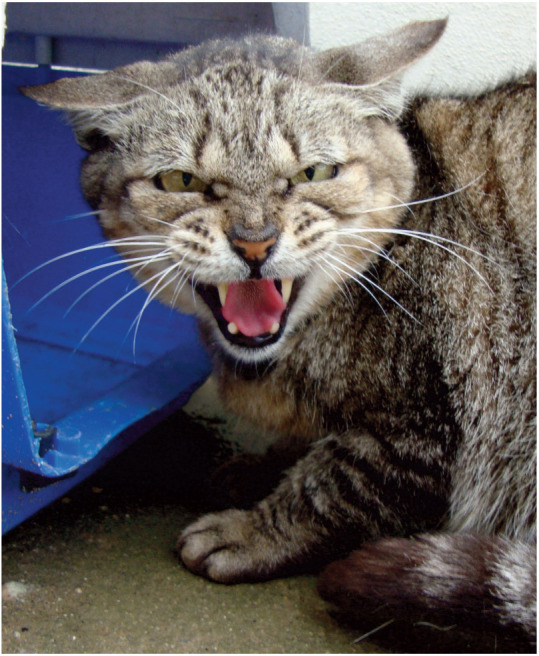
Hissing is one behavioural strategy that an anxious or fearful cat will use to repel a perceived stressor. Courtesy of Daniela Ramos
Acquisition of information responses
Cats experiencing activation of the fear-anxiety system are often hypervigilant. Since they perceive they are at risk of harm, they spend a great deal of time visually scanning the environment to gain as much visual information about potential stressors as possible. If there is only one stressor in clear sight, such as a dog, the cat may fixate its eyes on it. In fact, all the sensory systems are sensitised at this time. Hence it will be common to see signs of active listening (eg, the ears being erect and directed towards a source of sound, or rotating to follow sound if the source of sound is moving) and information gathering through the olfactory (sniffing) and possibly vomeronasal (flehmen behaviour) senses. Due to such sensitisation, the slightest noise, touch or fast movement could make the cat startle.
Specific body language and postures
Although Leyhausen carried out work in the 1970s on the body language and facial expressions of the domestic cat, 15 as Bennett and colleagues point out, 16 this early work was largely anecdotal and linkage of behaviours to emotional motivations confused. Until recently, there was a paucity of research in this area, and information on how to distinguish emotional motivations based on body language came almost solely from hypotheses derived from observations of professionals in the field such as veterinarians, specialist behaviourists and animal welfare scientists. More recently there has been a resurgence of scientific interest in the area, with empirical evidence emerging from studies involving objective measurements to substantiate some of the professional observations. Such measurements comprise detailed video analysis of specific parts of the cat’s body using objective techniques such as the Cat Facial Action Coding System (CatFACS) which measures the facial expressions of the domestic cat. 17
Body
Anxious and fearful cats often hold their body close to the ground with all four feet planted firmly on the floor in a ventral flat posture (Figure 3).7,12 The feet are often under the body and therefore not visible and the pads are usually in contact with the surface they are on. Such a posture protects vulnerable areas such as the belly as well as ensuring the cat is in a position for quick retreat if needed.
Figure 3.
An anxious/fearful cat displaying a hunched body with feet firmly placed underneath it. Courtesy of Daniela Ramos
Musculature is tense and assessment of it can be used to help distinguish between a frozen and a relaxed cat during handling. In extremely fearful cats, the body may shake or tremble.
Head and neck
The head is often pulled in close to the body, so that the neck is not visible at all. in many situations, the head appears lower than the body as if the cat is making itself as small as possible to protect itself. There is some evidence to suggest that at lower intensities of fear (eg, when cats in hospital cages are observed from a distance) their head is turned to the left-hand side more than the right. 16 Interestingly, across many species a left gaze bias is associated with right hemispherical dominance for the processing of more negative stimuli. 18 Lateralised behaviours are of interest because recent research points to a relationship between lateralisation and emotional functioning in animals (including cats) as well as humans. For example, one study suggested that motor laterality, in this case in the form of the presence or absence of paw preference, is related to temperament of the cat and thus its predisposition to experiencing specific emotional motivations. 19
Ears
Preliminary research has indicated that cats tend to flatten their ears downwards when in contexts associated with acute anxiety or fear-inducing stimuli (Figure 4). 20
Figure 4.
Note the flattened ears of this cat as it spots a nearby approaching dog. Courtesy of Hannah Wright
Although this pilot work was conducted in captive Scottish wildcats, recent observations in caged domestic cats highlight that similar types of ear movements also occur in fearful conditions in domestic cats, at least when in close proximity to or interacting with a person. 16 In very fearful cats, approach of a person has been observed to lead to a cat’s ears becoming so flattened (a combination of moving downwards and also rotating backwards against the head) that they are no longer visible, producing a very rounded head shape. In contexts where fear is related to an approaching person and retreat is not possible, such as the case in caged or physically restrained cats, frustration cannot be ruled out as an additional underlying activated emotional motivation since the cat is denied the opportunity to escape to safety – a resource it desires. Therefore, the flattened ear position observed in domestic cats in the above study may reflect a combination of the two emotional systems being activated.
Lateralisation with a left bias (and right hemisphere processing of threatening and alarming stimuli) has been described in the ears as well as in the gaze. Siniscalchi and colleagues found that cats were more likely to turn their head with their left ear leading than their right when orientating potentially threatening sounds (dog vocalisations), but were more likely to turn their head with their right ear leading when the sounds were cats meowing and purring. 21
Tail
In the anxious/fearful cat the tail is often clamped tightly, wrapping closely around the body; in some instances, it is tucked under the body so is not visible – most likely, to protect it from any potential harm.
Eyes
The eyes can vary a great deal in their presentation in anxious and fearful cats. When freezing, cats can demonstrate further avoidance by averting eye contact with the stressor, either by closing the eyes or turning the head (although some cats will visually fixate on stimuli to gather further information). The closed eyes are frequently pressed so firmly
At the other end of the spectrum, widely open eyelids revealing large round eyes with dilated pupils is a common sight in highly fearful cats (Figure 5) due to the increased physiological arousal they experience. However, large eye aperture and dilation of the pupils is also a common sign of increased physiological arousal associated with positive emotional motivations such as SEEKING, and thus should be used to assess arousal levels rather than emotional motivation per se. Furthermore, both blinking and half-blinking have recently been shown to be associated with fear when a cat is in close proximity to or interacting with a person. 16 Such blinking may have the function of protecting the eyes from harm as well as a possible communicative function.
Figure 5.
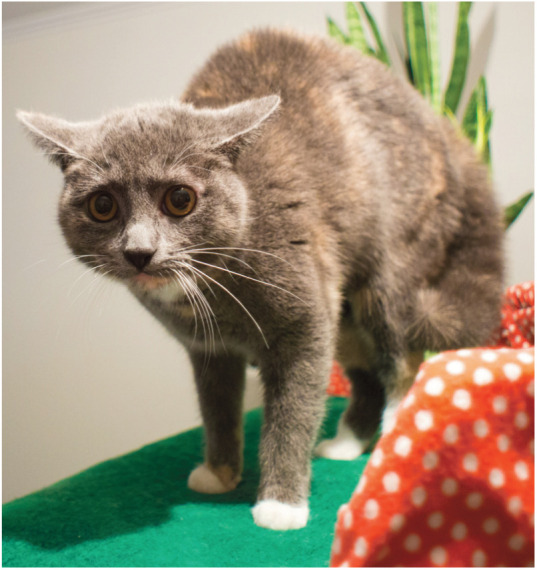
An anxious/fearful cat showing open round eyes and dilated pupils, as well as flattened ears, a tail wrapped close to the body and piloerection of the fur. Image ©iStock/pilriMiracle
Fur and skin
Anxious and fearful cats may exhibit piloerec-tion of their fur, most commonly across the tail and along the back. This often occurs with a startle response when the stressor is unexpected and sudden. Where startling occurs, the cat is more likely to show a body posture of standing tall rather than a crouched body posture, in preparation to flee if the stressor intensity increases. Like eye aperture and pupil dilation, piloerection may simply reflect the intensity of physiological arousal as it is also witnessed in some cats thought to be experiencing frustration.
Frustration responses
Behavioural expressions
As for anxiety and fear, differing levels of activation of the frustration system will lead to different behavioural expressions of the emotional motivation. Likewise, experiencing the emotional motivation in different contexts may lead to varying expressions. For example, frustration-related behaviours include changes in vocalisations such as meowing excessively, changes in mobility including increased focus on circling, rubbing and pacing, as well as scratching. Frustration responses are geared towards increasing the cat’s chances of obtaining what it wants, whether this is in relation to positive stimuli (eg, accessing food) or negative stimuli (eg, escaping from a veterinary cage). Behaviours that allow the cat to gain greater control within a specific context are key. Responses may therefore be vigorous, include aggression, may be geared towards attracting attention (noisy and active), and be redirected to an alternative target if the actual intended target is out of reach.
Frustrated cats are often vocal (Figure 6) and, while cats differ hugely in how vocal they are on a day-to-day basis, when frustrated, vocalisations tend to intensify in comparison with what is normal for an individual cat. Meowing is a common vocalisation associated with frustration but it can be differentiated from meowing that occurs alongside activation of other emotional systems by the heightened intensity in which it is performed.8,10 For example, compared to what is normal for the cat, it tends to occur in bouts of longer duration, or in more frequent bouts and/or at louder volume.5,7,13 owners may find the vocalisations of cats in contexts believed to induce frustration less pleasant than those produced relating to positive emotional motivations. 10 It is critical for emotional diagnosis to know what is the normal patterning of vocalisations for a cat.
Figure 6.
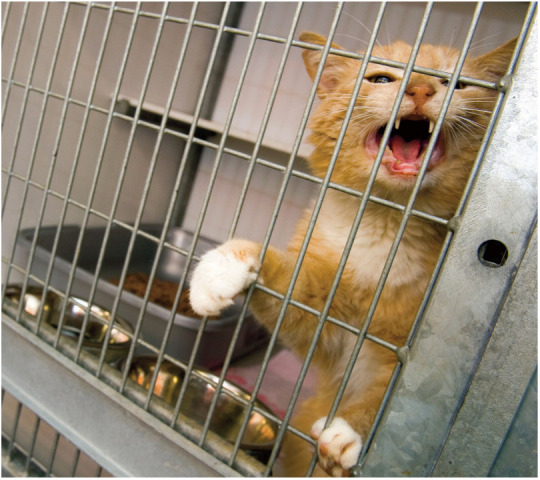
A frustrated caged cat vocalises and rears up at the cage bars in an attempt to attract attention. Image ©buurserstraat386/123RF
No study has specifically investigated the incidence and role of facial rubbing and scratching in association with frustration. However, when in the presence of people, many cats have been observed to display increased facial rubbing (of those people and the environment) and scratching (of the environment) when frustrated due to inability to obtain a specific resource. For example, a cat may excessively rub or scratch the doorframe of the door that leads outside if it cannot get outside, and may excessively rub the legs of the owner or nearby furniture when food is being withheld when it is expected.
If the source of frustration is physical confinement a cat will often target its frustration at the physical barrier(s) causing the confinement. Examples of such behaviours include pacing back and forth in front of the barrier, pawing at the barrier with one or both front feet, standing up on their hind legs with or without their body weight against the physical barrier, biting and scratching at the barrier and, in some cases, even attempting to push their body weight against the barrier. 7 Rearranging or disrupting resources is also a common behaviour of a cat that is frustrated related to confinement. 22 For example, cats kept in veterinary cages may upturn their litter tray and food/water bowls, and move their bedding overnight. It is thought that this rearranging comes with increased activity in a small confined space and may be the result of thwarted attempts to escape or a lack of suitable environment or sensory stimulation. It should not be confused with the disruption that can occur when a cat is anxious or fearful and moves resources in an attempt to create a safe place; for example, moving the bedding so that it can hide behind or underneath it, which likewise usually occurs at night.13,23 However, this is not to say that some cats may not also try to escape when feeling fearful and so an assessment of the cage should always occur in conjunction with assessing the cat before deducing emotional motivations.
For cats that find being physically restrained frustrating, or those that are additionally acutely fearful and unable to escape, frustration may take the form of aggression (see box). Aggression is a common feature of frustration, particularly at heightened activation of the emotional system and when at least one stressor involved is social; for example, a person or another cat.
Finally, when frustrated, cats may rapidly switch between behaviours, with each incidence of behaviour only occurring for a short period of time. Frustrated cats therefore often appear diverse in their behavioural presentation whereas anxious and fearful cats tend to show behaviours of greater duration or do not show as many behavioural transitions.
Specific body language and postures
Body
As frustrated cats tend to be more active than fearful and anxious cats, there is not one general body posture that characterises frustration. Where frustration is related to confinement, movement of the body associated with attempts to escape is common; for example, in stainless steel veterinary cages, cats thought to be frustrated have been seen to hang upside down on the cage door (Figure 7) and, as described earlier, push their body weight against the cage door. 7
Figure 7.
A frustrated cat placing its paws through the bars and trying to escape from the cage. Courtesy of Nadine Gourkow
Ears
Both flattening of the ears and rotation of the ears have been found to be associated with contexts related to frustration. Bennett and colleagues reported that flattened ears were associated with the context of frustration involving no interaction with people while ears were rotated when people were involved. 16 Finka and colleagues’ pilot work on Scottish wildcats found downwards flattening of the ears only to be associated with fear, and rotation of the ears only to be associated with frustration, in particular a right rotation bias. 20 However, the contexts and associated stimuli in which such emotions were induced were different from those studied by Bennett and colleagues. 16
Tail
Although no empirical studies report on tail posture or movements when frustration is activated, thrashing of the tail (in all directions) has been observed in cats in contexts which are likely to involve frustration; for example, when a cat is viewing another cat within its territory but is unable to defend that territory effectively (perhaps the cat has been shut indoors but normally has outdoor access and so considers the immediate outdoors part of its territory).
Eyes
Bennett and colleagues 16 found that cats tend to gaze upwards when in a context of frustration (caging) without human interaction. This gaze was not seen when the context involved human interaction and instead was replaced with half-blinking. However, these investigators also found half-blinking to be a feature associated with fear and thus interpretation of half-blinking should be undertaken with care.
Mouth
A number of specific movements of the mouth have been found to be associated with frustration. 16 These comprise tongue showing, dropping of the jaw, raising of the upper lip, lower lip depression, parting of the lips and mouth stretching.
Nose
Both nose wrinkling and nose-licking have been observed to occur in situations associated with frustration. 16
Fur and skin
Although not scientifically investigated, rippling and twitching of the skin is commonly witnessed in situations hypothesised to cause frustration, such as physical confinement, invasion of territory and restraint from handling. However, this is not exclusive to frustration-related contexts; it has been witnessed in contexts where motivational conflict may exist (eg, a cat that is usually very sociable with people is in the presence of someone who is very loud or moving abruptly, or perhaps someone it enjoys a positive relationship with but who on this occasion is with an excitable dog, and so the cat is experiencing SEEKING but is also anxious and hence conflicted) or just anxiety alone (for example, a cat in a veterinary waiting room). As mentioned for anxiety and fear, with intense activation of frustration, piloerection of the fur may occur.
Gaining information from the owner to reach an emotional diagnosis
While the behaviour, body language and posture of a cat in the veterinary clinic can be directly observed, it is important to remember that the context of the veterinary clinic is likely to inflate existing negative emotional motivations or even activate negative emotional systems that are inactive in the home. Therefore, to get a clear picture of what emotions the cat is experiencing in relation to the problem behaviour, it is important to gain this information from direct observations in the home and owner questioning. While direct home observations are only possible for those able to do home visits, owners can be asked to film the cat’s behaviour at home, even on something as simple as their mobile phone, and bring the footage to the clinic for assessment.
In addition, taking the time in the clinic for detailed questioning of the owner can help to formulate an idea of how the cat behaves and what it looks like in terms of its body postures and body language at home. This information is particularly important for identification of specific problem behaviours and subsequent behavioural advice and/or referral to a specialist behaviourist if needed. It also helps to identify those cats whose owners may not be concerned about problem behaviour but whose welfare is not necessarily optimised, as well as those that are at possible risk of developing problem behaviour in the future. Avoiding closed questions that are likely to lead to a yes or no answer is important. For example, asking an owner if their cat hides provides very little information if the answer received is yes or no or even sometimes. Questions should be structured to target specifics regarding the presentation of a behaviour (eg, frequency, duration, intensity, location, timing and latency [time to onset of the behaviour in relation to other behaviours, postures and facial expressions]).
Evaluating the behavioural information alongside information obtained from a stres-sor audit (a questionnaire or form designed to identify stressors in the social and physical environment of the cat) can help a veterinarian recommend improvements that can be made to the cat’s environment and/or husbandry practices to improve quality of life. Improved welfare will not only help prevent the occurrence of problem behaviour but also reduce the risk of stress-related disease. Standardised published ethograms with written descriptions of behaviour 27 and pictorial representations of body language 28 can be used to help owners identify how their cat looks and behaves. These help to avoid ambiguity between individuals when using behaviour terminology. However, since behaviour is not static, sharing video examples with clients is best, such as those in the online ethogram ‘Cat Behaviour Described’. 29
Key Points
Identifying which underpinning emotion(s) are involved in the presentation of problem behaviour is vital to successful treatment and optimising the welfare of the individual cat.
Good observational skills are very important in facilitating the identification of behaviours, and body language and postures associated with an emotional response.
Anxiety and fear are displayed by cats in a number of ways and behavioural expression can be categorised into responses that either increase space and decrease interaction, or result in the acquisition of information.
Frustration responses are geared towards increasing the cat’s chances of obtaining what it wants – whether in relation to positive or negative stimuli.
Frustrated cats often transition from one behaviour to another quickly, whereas anxious and fearful cats tend to remain in one behaviour for longer periods of time.
The behavioural assessment of pain is notoriously difficult in cats and, as they are known to mask pain well, the absence of behavioural signs should never be used as confirmation that there is absence of pain.
The context of the veterinary clinic is likely to inflate existing negative emotions or even create negative emotions that are absent in the home. In order to get a clear picture of what emotional systems the cat is experiencing in relation to the problem behaviour, it is important to utilise direct observations in the home and owner questioning.
Supplemental Material
Special issues on feline behaviour and problem behaviours
Footnotes
The author is an employee of International Cat Care, the parent charity of the International Society of Feline Medicine (ISFM), and has written this article in her capacity as a behaviour specialist.
Funding: The author received no financial support for the research, authorship, and/or publication of this article.
References
- Panksepp J. Affective neuroscience: the foundations of human and animal emotions. Oxford University Press, USA, 1998. [Google Scholar]
- Craig AD. A new view of pain as a homeostatic emotion. Trends Neurosci 2003; 26: 303-307. [DOI] [PubMed] [Google Scholar]
- LeDoux JE, Hofmann SG. The subjective experience of emotion: a fearful view. Curr Opin Behav Sci 2018; 19: 67-72. [Google Scholar]
- Mendl M, Burman OH, Paul ES. An integrative and functional framework for the study of animal emotion and mood. Proc R Soc Lond B Biol Sci 2010; 277: 2895-2904. [DOI] [PMC free article] [PubMed] [Google Scholar]
- Carlstead K, Brown JL, Strawn W. Behavioural and physiological correlates of stress in laboratory cats. Appl Anim Behav Sci 1993; 12: 143-158. [Google Scholar]
- Kry K, Casey R. The effect of hiding enrichment on stress levels and behaviour of domestic cats (Felis sylvestris catus) in a shelter setting and the implications for adoption potential. Anim Welfare 2007; 16: 375-383. [Google Scholar]
- Gourkow N, Lavoy A, Dean GA, et al. Associations of behaviour with secretory immunoglobulin A and cortisol in domestic cats during their first week in an animal shelter. Appl Anim Behav Sci 2014; 150: 55-64. [Google Scholar]
- Nicastro N, Owren M J. Classification of domestic cat (Felis catus) vocalizations by naive and experienced human listeners. J Comp Psychol 2003; 117: 44. [DOI] [PubMed] [Google Scholar]
- de Rivera C, Ley J, Milgram B, et al. Development of a laboratory model to assess fear and anxiety in cats. J Feline Med Surg 2017; 19: 586-593. [DOI] [PMC free article] [PubMed] [Google Scholar]
- Ellis SL, Swindell V, Burman OH. Human classification of context-related vocalizations emitted by familiar and unfamiliar domestic cats: an exploratory study. Anthrozobs 2015; 28: 625-634. [Google Scholar]
- Maier SF, Seligman ME. Learned helplessness: theory and evidence. J Exp Psychol Gen 1976; 105: 3. [Google Scholar]
- Mills DS. What are stress and distress, and what emotions are involved? In: Ellis S, Sparkes A. (eds). ISFM guide to feline stress and health: managing negative emotions to improve feline health and wellbeing. Tisbury: International Society of Feline Medicine, 2017, pp 7-18. [Google Scholar]
- McCune S. Temperament and welfare of caged cats. PhD dissertation. University of Cambridge, UK, 1992. [Google Scholar]
- Panksepp J. Affective consciousness: core emotional feelings in animals and humans. Conscious Cogn 2005; 14: 30-80. [DOI] [PubMed] [Google Scholar]
- Leyhausen P. Cat behavior: the predatory and social behavior of domestic and wild cats. New York: Garland STPM Press, 1979. [Google Scholar]
- Bennett V, Gourkow N, Mills DS. Facial correlates of emotional behaviour in the domestic cat (Felis catus). Behav Processes 2017; 141: 342-350. [DOI] [PubMed] [Google Scholar]
- Caeiro CC, Waller BM, Burrows AM. CatFACS: the cat facial action coding system manual. Department of Psychology, University of Portsmouth, UK, www.CatFACS.com (2013, acessed March 23 2018).
- Beaver B. Fractious cats and feline aggression. J Feline Med Surg 2004; 6: 13-18. [DOI] [PMC free article] [PubMed] [Google Scholar]
- McDowell LJ, Wells DL, Hepper PG, et al. Lateral bias and temperament in the domestic cat (Felis silvestris). J Comp Psychol 2016; 130: 313-320. [DOI] [PubMed] [Google Scholar]
- Finka L, Ellis SLH, Wilkinson A, et al. The development of an emotional ethogram for Felis silvestris focused on FEAR and RAGE. J Vet Behav Clin Appl Res 2014; 9: e5. [Google Scholar]
- Siniscalchi M, Laddago S, Quaranta A. Auditory lateralization of conspecific and heterospecific vocalizations in cats. Laterality 2016; 21: 215-227. [DOI] [PubMed] [Google Scholar]
- Gourkow N, Phillip C. Effect of cognitive enrichment on behavior: mucosal immunity and upper respiratory disease of shelter cats rated as frustrated on arrival. Prev Vet Med 2016; 131: 103-110. [DOI] [PubMed] [Google Scholar]
- Gourkow N, Fraser D. The effect of housing and handling practices on the welfare, behaviour and selection of domestic cats (Felis sylvestris catus) by adopters in an animal shelter. Anim Welfare 2006; 15: 371-377. [Google Scholar]
- Ellis SL, Rodan I, Carney HC, et al. AAFP and ISFM feline environmental needs guidelines. J Feline Med Surg 2013; 15: 219-230. [DOI] [PMC free article] [PubMed] [Google Scholar]
- Merola I, Mills DS. Systematic review of the behavioural assessment of pain in cats. J Feline Med Surg 2016; 18: 60-76. [DOI] [PMC free article] [PubMed] [Google Scholar]
- Merola I, Mills DS. Behavioural signs of pain in cats: an expert consensus. PloS One 2016; 11: e0150040. doi: 10.1371/journal.pone.0150040. [DOI] [PMC free article] [PubMed] [Google Scholar]
- Stanton LA, Sullivan MS, Fazio JM. A standardized ethogram for the felidae: a tool for behavioral researchers. Appl Anim Behav Sci 2015; 173: 3-16. [Google Scholar]
- UK Cat Behaviour Working Group. An ethogram for behavioural studies of the domestic cat (Felis silvestris catus L), UFAW Research Report 8. Universities Federation of Animal Welfare, Hertfordshire, 1995. [Google Scholar]
- International Cat Care. Cat behaviour described. http://icatcare.org/behaviour-described (2017, accessed March 23, 2018).
Associated Data
This section collects any data citations, data availability statements, or supplementary materials included in this article.
Supplementary Materials
Special issues on feline behaviour and problem behaviours



